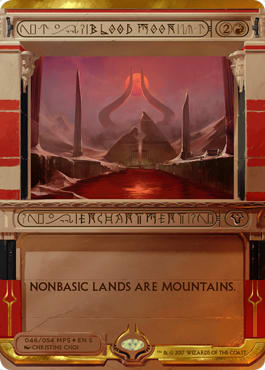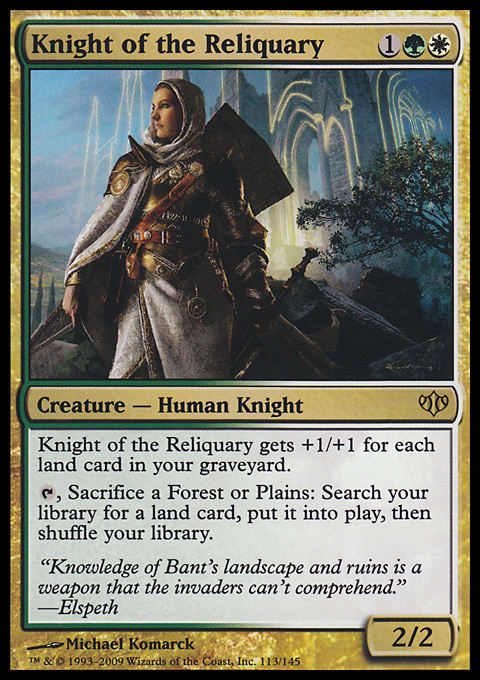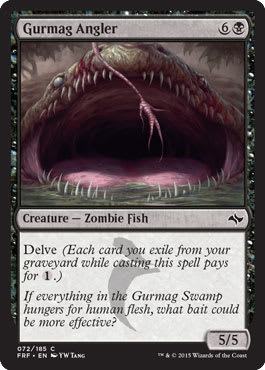As always, the Legacy metagame moves like molasses in the summertime heat. Indeed, part of the appeal of Legacy for many enfranchised players is the fact that they can draw on a wealth of experience when preparing for a tournament, as the games they played in 2015 are still relevant to the format today. Compare that to Standard, where Siege Rhino and Collected Company are distant memories by now, and the format shifts unpredictably with the release of new sets every three months. The huge repository of past experience with the same (or similar) 75 cards makes for a format where folks can come back and enjoy playing with their favorites year after year. Generally, the careful balance of power in Legacy keeps most innovations from being too impactful; however, a true Legacy aficionado never stops trying to break it. The corollary, though, is that since many opponents will be playing the same or similar decks as they’ve been playing for years, the play patterns they are used to (and the cards they’re used to playing against) remain as stagnant as the metagame. Therefore, a smart Legacy player can take advantage of their inflexibility by playing a rogue deck, incorporating a transformative sideboard plan, or packing an unexpected engine or hate card that can upend their entire strategy.
Examples of these sorts of unexpected (and potentially game-breaking) tweaks include Blood Moon in midrange Blue decks, combo decks, or ![]()
![]() Delver decks, Crucible of Worlds, Life from the Loam, Sylvan Library, or Jace, the Mind Sculptor in Delver decks, Punishing Fire/Grove of the Burnwillows or Thopter Foundry/Sword of the Meek in any midrange deck that can support them, Monastery Mentor in the sideboard of (mostly) creatureless
Delver decks, Crucible of Worlds, Life from the Loam, Sylvan Library, or Jace, the Mind Sculptor in Delver decks, Punishing Fire/Grove of the Burnwillows or Thopter Foundry/Sword of the Meek in any midrange deck that can support them, Monastery Mentor in the sideboard of (mostly) creatureless ![]()
![]() Control decks, or odd Planeswalkers like Dack Fayden or Daretti, Ingenious Iconoclast in whatever brews might make use of their abilities. The list goes on and on, as there are a number of obscure cards that allow decks to reposition themselves in a number of matchups, many of which will make most opponents furrow their brows, read the card, and run for the hills. Part of the beauty of Legacy is “catching” opponents with tricky feints like these, and the interplay between players trying to hedge against jukes while sideboarding for the main strategy. For this reason, it seems natural for a brewer to attempt to mix and match different “juke packages” with different Blue midrange shells in order to find the ones that opponents will not be able to beat on a given weekend. Whether it’s Ethan Gaieski (morticiansunion on MTGO) playing the following monstrosity or yours truly jamming Blood Moon into Dimir Garbage, the key to brewing in Legacy is to mix and match different card clusters to see which ones opponents won’t see coming. (That said, you’re almost universally priced into playing Brainstorm, Deathrite Shaman, Ponder, and the like, simply because of the high power level of those spells.)
Control decks, or odd Planeswalkers like Dack Fayden or Daretti, Ingenious Iconoclast in whatever brews might make use of their abilities. The list goes on and on, as there are a number of obscure cards that allow decks to reposition themselves in a number of matchups, many of which will make most opponents furrow their brows, read the card, and run for the hills. Part of the beauty of Legacy is “catching” opponents with tricky feints like these, and the interplay between players trying to hedge against jukes while sideboarding for the main strategy. For this reason, it seems natural for a brewer to attempt to mix and match different “juke packages” with different Blue midrange shells in order to find the ones that opponents will not be able to beat on a given weekend. Whether it’s Ethan Gaieski (morticiansunion on MTGO) playing the following monstrosity or yours truly jamming Blood Moon into Dimir Garbage, the key to brewing in Legacy is to mix and match different card clusters to see which ones opponents won’t see coming. (That said, you’re almost universally priced into playing Brainstorm, Deathrite Shaman, Ponder, and the like, simply because of the high power level of those spells.)
Let’s take a look at Ethan’s monstrosity, Mortician’s Delver:
Mortician?s Delver ? Legacy | Ben Friedman
- Creatures (14)
- 3 Knight of the Reliquary
- 3 Stoneforge Mystic
- 4 Deathrite Shaman
- 4 Delver of Secrets
- Instants (21)
- 1 Zealous Persecution
- 2 Fatal Push
- 2 Spell Pierce
- 4 Brainstorm
- 4 Daze
- 4 Force of Will
- 4 Swords to Plowshares
- Sorceries (4)
- 4 Ponder
- Artifacts (2)
- 1 Batterskull
- 1 Umezawa's Jitte
- Lands (19)
- 1 Scrubland
- 2 Tropical Island
- 2 Tundra
- 2 Underground Sea
- 4 Flooded Strand
- 4 Polluted Delta
- 4 Wasteland
- Sideboard (15)
- 3 Thoughtseize
- 3 Surgical Extraction
- 1 Karakas
- 2 Disenchant
- 2 Snapcaster Mage
- 2 Flusterstorm
- 2 Zealous Persecution
Wow. Not only did Ethan break several cardinal rules of Delver deck-building, he did them all at once, while also stretching the mana base for . . . Knight of the Reliquary! Knight is certainly an odd 3-drop threat to choose, but Ethan made Top 4 of the Legacy MTGO Challenge this past weekend, so who am I to criticize? For what it’s worth, this is essentially an Esper Deathblade deck with Delver of Secrets and Knight of the Reliquary over a land, a fourth Stoneforge Mystic, True-Name Nemesis, and the other “spice” cards that might get in a midrange pile deck. The power here is in the fact that as a Delver deck, many opponents will expect the games to play out a certain way, but with a “protect the Queen” style strategy revolving around Knight of the Reliquary, Ethan can use his Delvers, Stoneforge Mystics, and Deathrite Shamans as lightning rods that soak up removal, leaving Knight ready to wreak havoc. The deck also speeds up its clock by playing Delver of Secrets over cards like Jace, the Mind Sculptor or Snapcaster Mage, which allows it some free win equity by virtue of just sometimes leading off with a pair of uncontested flying Wild Nacatls. Ethan’s is an interesting strategy, for sure, but like many Delver strategies, there is one glaring weakness in the deck, one that Moon Grixis Garbage attempts to exploit. Like many multicolored piles, as well as many Delver of Secrets strategies,
This list stems from earlier work pre-GP Las Vegas, when I spent two weeks brewing and testing in an attempt to get something spicy going for the format.
Moon Grixis Garbage ? Legacy| Ben Friedman
- Creatures (11)
- 3 Gurmag Angler
- 4 Deathrite Shaman
- 4 Snapcaster Mage
- Planeswalkers (2)
- 2 Jace, the Mind Sculptor
- Instants (17)
- 1 Kolaghan's Command
- 2 Fatal Push
- 2 Lightning Bolt
- 2 Spell Pierce
- 2 Thought Scour
- 4 Brainstorm
- 4 Force of Will
- Sorceries (9)
- 2 Thoughtseize
- 3 Collective Brutality
- 4 Ponder
- Enchantments (2)
- 2 Blood Moon
- Lands (19)
- 1 Mountain
- 2 Swamp
- 3 Island
- 1 Tropical Island
- 1 Underground Sea
- 1 Volcanic Island
- 2 Bloodstained Mire
- 4 Polluted Delta
- 4 Scalding Tarn
- Sideboard (15)
- 3 Diabolic Edict
- 3 Surgical Extraction
- 2 Thoughtseize
- 2 Engineered Explosives
- 2 Toxic Deluge
- 2 Flusterstorm
- 1 Kolaghan's Command
The reasons for playing the deck shown here can be broken down into three constituent parts.
1: You are a Delver-esque cantrip engine deck, with more mana sources than most Delver decks (16 turn-one blue sources, 14 turn-one Deathrite sources)
In essence, this deck plays a very similar game to most Delver decks, with heavy cantripping, Gurmag Angler as a one-mana 5/5, and cheap and plentiful removal and disruption. However, this deck (unlike Delver decks) has a few aces up its sleeves in Blood Moon. Blood Moon is an automatic game over when resolved on most stabilized boards, which puts this deck in the comfortable position of “slightly bigger in the semi-mirror, with a potential auto-win on 3 mana”. That’s a great position to be in against the largest macro-archetype of the format.
Additionally, the deck sports a healthy quantity of cheap removal, with Snapcasters to back it up, and tons of discard and countermagic to fight most combo decks. Triple Thoughtseize on the opponent followed by a Gurmag Angler or Jace, the Mind Sculptor is generally going to be good enough, despite a lower pressure quotient due to lack of Delver of Secrets. The matchup is worse than Grixis Delver’s matchup against combo, for sure, but it is salvageable with certain tweaks to the deck. Just be sure to bring in Engineered Explosives against Storm to prepare for a warren full of Goblins!
You also have a solid matchup against Death and Taxes, as their mana base harassment is weaker against your basic-heavy mana base, and Kolaghan's Command, Engineered Explosives, and Toxic Deluge all do stellar work in the matchup.
Elves, unfortunately, is a slightly weaker matchup for Moon Grixis than for Delver decks, as the lack of pressure means that the elf army can rebuild through multiple removal spells. To improve the matchup there would require Grim Lavamancer or Leovold, Emissary of Trest, neither of which sound terribly appealing in this deck. The best bet here is to land an early Gurmag Angler and back it up with a few removal spells or a Toxic Deluge, while countering the opponent’s attempts at Natural Order.
2: The chuckler Blood Moon decks do nothing against you
Every time someone casts a turn-one Blood Moon against a Delver deck, I die a little inside. It’s a part of Legacy, and it deserves respect, but the turbo-Blood Moon all-in decks are possibly the least enjoyable component of the format, and playing Delver means that you’re always worried about a matchup that often comes down to the quality of the top seven cards of your opponent’s deck. Enter Moon Grixis Garbage, a deck that laughs at first-turn Blood Moons and packs the cards necessary to combat Trinisphere, Chalice of the Void, and Chandra, Torch of Defiance alike. It’s always enjoyable to watch the Blood Moon decks flail around when their Plan A doesn’t proves ineffective, and this deck has the tools to render All-In Red helpless.
3: You have chuckler Blood Moon capability with Deathrite-Blood Moon openings (or just regular turn-three Blood Moons with counter backup)
Most Delver decks are heavy dogs to Lands, which is on the rise and has always been the bane of fair midrange Blue decks. Things shift dramatically when you pack Blood Moon, sideboard Surgical Extractions, and sideboard Diabolic Edicts. Gurmag Angler is resilient to Punishing Fire, and if it’s backed up by a single Blood Moon it will often put the game out of reach. Additionally, Blood Moon does wonders against Eldrazi, Delver (as previously mentioned), and various three- and four-color midrange piles. (Think Deathblade, Czech Pile, etc.) A third Blood Moon in the 75, or possibly a fourth Surgical Extraction in the sideboard would both be welcome additions to hedge against Lands.
Now, like with most brews, there is still a ton of work to be done. Possible routes for exploration with the Moon Grixis Garbage list include:
- Messing with the land count, as it’s possible that the list could drop to only 18 lands to include another cantrip. It’s also possible that a single Badlands could make its way into the list, to promote Island-Badlands starts that allow you to cast cantrips and removal without a hitch.
- Adding a fourth Gurmag Angler and third Thought Scour, to power out more turbo-Gurmags. The best openings with the deck involve a fetchland and a Thought Scour, which make for a turn-two Gurmag Angler and a dead opponent.
- Including a copy of Tasigur, the Golden Fang. The idea here is to have a card-draw engine to compete on raw cards with the Baleful Strix Czech Pile decks.
- Adding Baleful Strix, Murderous Cut, or Dismember as a way to handle opposing Gurmag Anglers. Just as this deck plays Gurmag Angler because it dodges much of the popular common removal, it is vulnerable to opposing Gurmag Anglers in its current configuration.
- Modifying the removal suite (as the Lightning Bolt/Fatal Push split is something of a guesstimation). It could easily become three Pushes, one Bolt, one Dismember, for example. Diversity in the removal suite is acceptable here because Snapcaster Mage magnifies the impact of each one, allowing extra utility in the narrow situations where one is better than the other. The heavy card selection means that you’re also quite likely to find the removal you need, whether it’s for killing an opposing Planeswalker or an opposing Tarmogoyf.
Losing Wasteland is a huge dent in the power level of a midrange Blue deck in Legacy, but gaining basic lands and Blood Moon offers a completely new angle of attack. There is certainly a Blue midrange shell out there that can properly include this powerful “one-card combo”, and it just remains to be seen if that shell is Grixis, Jeskai, or even straight-up ![]()
![]() or Temur. Within each of those color combinations there are also a ton of variables. Grixis can be built with turbo-Gurmag Angler in mind, or it could be built with Thopter-Sword and an artifact sub-theme. Hell, a Temur Punishing Fire Blood Moon deck doesn’t sound all that bad, come to think of it . . .
or Temur. Within each of those color combinations there are also a ton of variables. Grixis can be built with turbo-Gurmag Angler in mind, or it could be built with Thopter-Sword and an artifact sub-theme. Hell, a Temur Punishing Fire Blood Moon deck doesn’t sound all that bad, come to think of it . . .
Next week, we’ll discuss Mentor Infect and Sinkhole Dimir Delver, two more Legacy brews that staple an unexpected angle onto a previously vetted powerful shell. Legacy is still a wonderfully untapped format, where there are potential breakthroughs hiding in sets old and new alike. It’s always a blast to mix and match and find the best combinations.
























